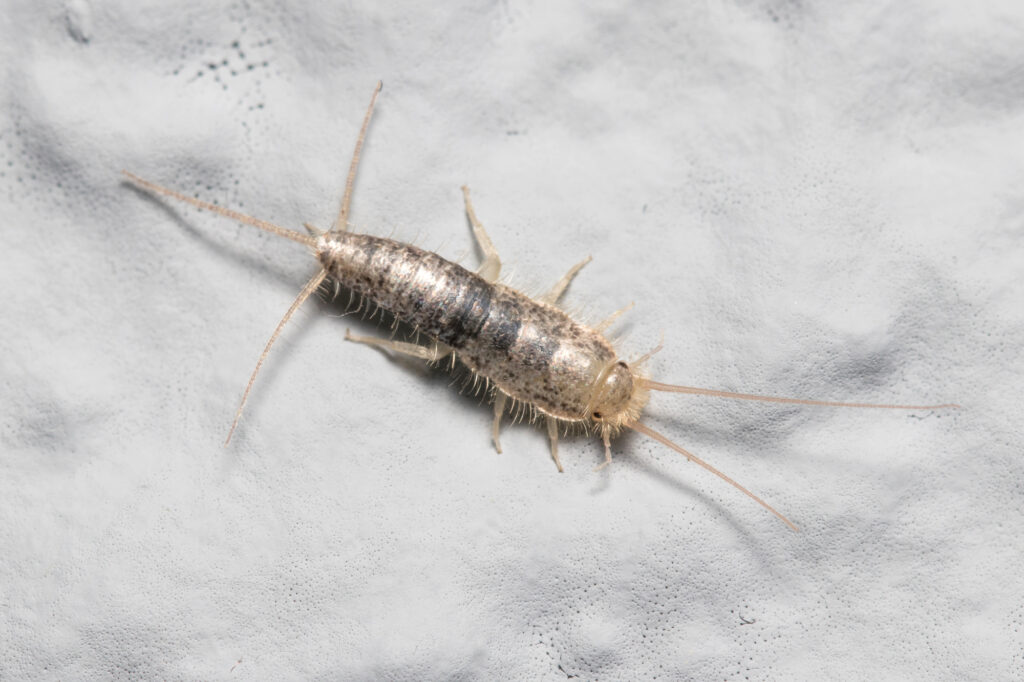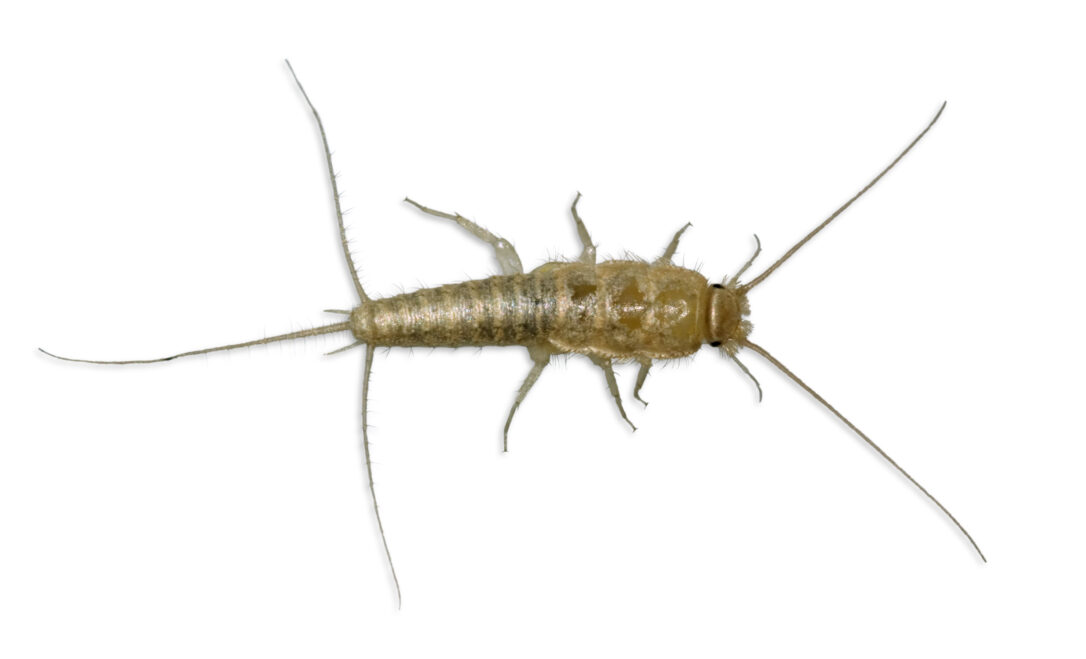Table of Contents
Introduction to Silverfish

Silverfish are small, wingless insects commonly found in homes and buildings. Despite their name, they aren’t fish, but instead belong to the insect order Thysanura. They’re often considered household pests, and their presence can indicate an underlying issue with your property. In this comprehensive guide, we’ll explore silverfish facts, what makes them a nuisance, and how to effectively treat and prevent infestations.
Physical Characteristics
Silverfish are typically 12-19 millimetres long, with a flattened, tapered body covered in silvery-grey scales. They have two long antennae on their head and three tail-like appendages called cerci, giving them a unique appearance. Silverfish are also known for their fish-like movements, as they can quickly scuttle across surfaces.
Silverfish are nocturnal creatures, meaning they’re most active during the night. They have compound eyes, which is unusual for their insect order, but these eyes are quite small and provide them with limited vision. They rely more on their antennae to navigate their surroundings and detect potential threats.
Silverfish Lifecycle
The lifecycle of a silverfish begins with the female laying eggs in a hidden location, such as cracks, crevices, or behind wallpaper. The number of eggs laid can vary, with some females laying just a few, while others may lay up to 100. Once hatched, the nymphs will undergo several moults before reaching adulthood, which can take several months to a few years, depending on the environmental conditions. Interestingly, silverfish are one of the few insects that continue to moult even after reaching maturity, and they can live for up to eight years.
Common Habitats
Silverfish thrive in damp, humid environments, which is why they’re often found in basements, bathrooms, kitchens, and laundry rooms. They tend to hide in tight spaces during the day, such as behind wallpaper, in book bindings, and underneath carpets, coming out to feed at night. Silverfish primarily consume carbohydrates, including starches, sugars, and cellulose found in common household items like books, wallpaper, and clothing.
In nature, silverfish can be found in leaf litter, under rocks, and in tree bark. They are also known to inhabit caves, as the conditions in these environments provide the humidity they require.
Types of Silverfish
There are several different species of silverfish, but the most common species found in homes is the Lepisma saccharina. Other species include the Ctenolepisma longicaudata, or the long-tailed silverfish, and the Ctenolepisma lineata, also known as the four-lined silverfish. While there are some differences in appearance and behaviour among these species, their overall impact as pests and the methods used to control them are similar.
Why Silverfish are Pests
Property Damage

While silverfish don’t transmit diseases, they can cause significant damage to your property. They’re notorious for their voracious appetite, munching on anything containing cellulose, starch, or protein. This can lead to ruined books, damaged wallpaper, and destroyed clothing and textiles. They may also damage photographs, cardboard boxes, and even insulation materials.
The damage caused by silverfish is often characterised by irregular-shaped holes or notches in the affected materials. Sometimes, they may leave behind a yellowish stain on the items they’ve been feeding on.
Allergens and Health Concerns
Silverfish can also be a source of allergens, as their scales, faeces, and shed exoskeletons can trigger allergic reactions in some people. Symptoms of a silverfish allergy may include sneezing, itchy eyes, and nasal congestion. Additionally, their presence often attracts other pests, like spiders, that feed on them, further complicating the issue.
Indicators of a Moisture Problem
A silverfish infestation can also be a sign that your home has an underlying moisture problem. Their preference for damp environments means that if you’re finding silverfish in your home, there’s a good chance that excess moisture is present. Addressing the moisture issue is crucial not only for controlling silverfish but also for preventing other problems, such as mould growth and structural damage.
How to Prevent Silverfish Infestations
Humidity Control
The key to preventing silverfish infestations is controlling the humidity levels in your home. Aim to keep the relative humidity below 50% to make the environment less hospitable for these insects. Consider using a dehumidifier in damp areas, such as basements or bathrooms, and fixing any leaks or sources of moisture. Proper ventilation is also crucial, especially in areas like bathrooms and kitchens, where moisture can accumulate.
Proper Storage
Store items like books, clothing, and paper products in a dry, well-ventilated area, preferably in sealed plastic containers. This will not only protect your belongings from silverfish but also make it harder for them to find a suitable hiding spot. Be mindful of how you store food, as well, as silverfish can be attracted to items like flour, sugar, and cereal. Use airtight containers to keep these items safe from pests.
Regular Cleaning
Maintaining a clean home can also help prevent silverfish infestations. Regularly vacuuming and dusting, especially in areas where silverfish may hide, will disrupt their environment and reduce the likelihood of them taking up residence. Pay special attention to dark, secluded areas, such as closets, basements, and attics.
Sealing Entry Points
Inspect your home’s exterior for any cracks or gaps that silverfish could use to enter. Seal these openings with caulk or another appropriate material. Be sure to check around doors, windows, and utility lines for potential entry points.
Effective Silverfish Treatments
Natural Remedies
If you’ve spotted a few silverfish in your home, you might want to try some natural remedies first. Diatomaceous earth, a powder made from the fossilised remains of tiny aquatic organisms, can be an effective treatment. Sprinkle it around infested areas, and it will damage the exoskeleton of the silverfish, eventually killing them. Another option is to create simple sticky traps using double-sided tape and cardboard, placing them in areas where silverfish are commonly found.
Other natural remedies include using essential oils, such as lavender, cedar, or citrus oils. These can be applied to infested areas or mixed with water and sprayed around the home to deter silverfish. Remember to test a small area first to ensure that the oils won’t cause any damage or staining.
Chemical Treatments
For more severe infestations, chemical treatments may be necessary. Insecticides specifically designed for silverfish control can be found at most home improvement stores. These may come in the form of sprays, powders, or bait stations. Always follow the manufacturer’s instructions for application and safety precautions. Keep in mind that while chemical treatments can be effective, they may also pose risks to humans, pets, and the environment. Use them as a last resort and consider other options first.
Professional Pest Control
In some cases, a professional pest control service may be the best solution. They have access to more potent treatments and can thoroughly inspect your property to identify and eliminate the source of the infestation. Professionals also have the knowledge and experience to ensure that treatments are applied safely and effectively. If you’re dealing with a persistent infestation or are unsure of the best course of action, contacting a professional is a wise decision.
Integrated Pest Management
An integrated pest management (IPM) approach combines prevention, monitoring, and control methods to effectively manage silverfish infestations. By addressing the underlying factors that contribute to an infestation and using a combination of treatment methods, IPM provides a more sustainable and environmentally friendly solution to pest control.
Long-Term Silverfish Control Strategies
Regular Inspections
Conducting regular inspections of your home can help identify any potential silverfish infestations before they become a significant problem. Check for signs of silverfish activity, such as damaged items or droppings, and address any issues immediately. It’s also essential to regularly inspect your home for moisture problems, as controlling humidity is crucial for silverfish prevention.
Ongoing Maintenance
Maintaining your home is essential for long-term silverfish control. Keep your property in good repair, promptly addressing any issues that may lead to moisture problems, such as leaking pipes or damaged roofing. Ensure that your home’s ventilation systems are functioning properly to maintain a dry environment.
Frequently Asked Questions
1- Can silverfish bite humans?
While silverfish have chewing mouthparts, they rarely bite humans, and their primary food sources are cellulose, starches, and sugars found in household items.
2- Are silverfish dangerous?
Silverfish are not considered dangerous to humans, as they don’t transmit diseases. However, they can cause damage to your belongings and potentially exacerbate allergies.
3- How do I know if I have a silverfish infestation?
Signs of a silverfish infestation include seeing silverfish themselves, finding damaged items like books or clothing, and spotting tiny, pepper-like droppings in infested areas.
Can I use home remedies to get rid of silverfish?
Home remedies, such as diatomaceous earth and sticky traps, can be effective in treating minor silverfish infestations. However, for larger infestations or persistent issues, professional pest control may be necessary.
4- How can I prevent silverfish from returning?
Preventing future silverfish infestations involves maintaining a clean and dry home, controlling humidity levels, and properly storing items that attract silverfish. Regular inspections and addressing potential entry points can also help keep silverfish at bay.
You may also enjoy reading this article
Was This Article Helpful?
- Please provide feedback and comments to help us improve our content.
- Share your experiences and any additional tips you have for dealing with pests.
Share this Post



